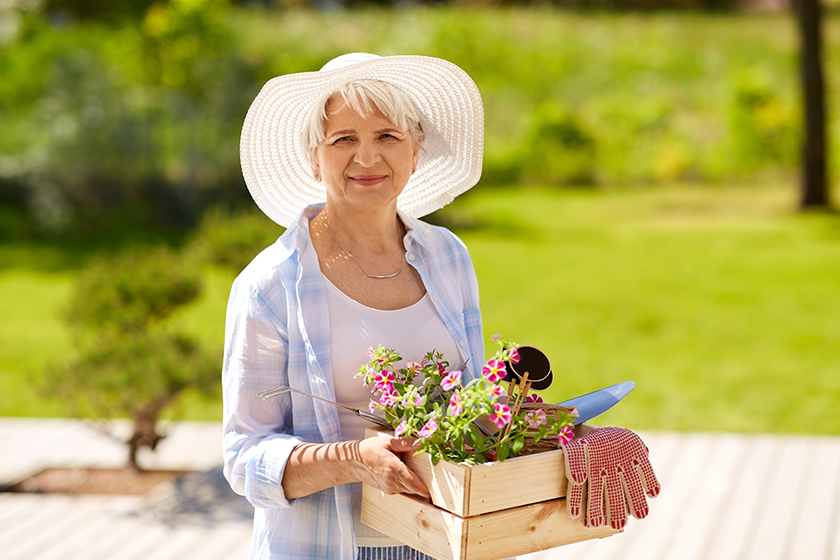In today’s fast-paced world, the concept of slow living offers a refreshing alternative—especially for those who seek peace, fulfillment and improved quality of life. Slow living is about intentionally stepping back from the rush and embracing a lifestyle that prioritizes mindfulness, simplicity and well-being.
For those in Independent Living communities, adopting this philosophy can transform daily routines, fostering a deeper connection to oneself, others and the environment.
This article explores how slow living can complement the Independent Living experience. We offer practical insights into incorporating this approach into daily life for better physical, emotional and social health.
What Is Slow Living?
Slow living isn’t merely about slowing down physically—it’s a comprehensive lifestyle philosophy that invites individuals to focus on what brings true fulfillment and joy. In a world often driven by deadlines and distractions, slow living challenges the need for constant urgency.
Instead, it advocates for a mindful approach to life, where intentional choices replace habitual rushing and quality takes precedence over quantity.
This philosophy revolves around mindfulness, urging individuals to stay present in the moment and fully engage with their surroundings. For older adults, it offers a way to reconnect with life’s simple pleasures—moments that often go unnoticed in the hustle of daily routines. If it’s the sensation of warm sunlight on your skin, the sound of birds chirping or the aroma of freshly brewed tea, slow living emphasizes appreciating the beauty and richness of every experience.
At its core, slow living is about intentionality—prioritizing what truly matters and letting go of the superfluous. It’s not about being idle; it’s about thoughtfully choosing activities, relationships and goals that align with personal values and bring satisfaction.
For those in retirement communities, this could mean engaging in hobbies that spark joy, cultivating relationships that nurture the soul or embracing a rhythm of life that feels balanced and sustainable.
In Independent Living communities, slow living takes on unique dimensions. It can manifest in countless meaningful ways:
- Savoring a Morning Ritual: if it’s enjoying a quiet cup of coffee while watching the sunrise or reading a favorite book in a cozy nook, these simple acts can become treasured moments of peace and reflection.
- Cultivating Connections: Slow living provides the opportunity to form deeper, more meaningful relationships with neighbors and friends, creating a sense of belonging and community.
- Appreciating Natural Beauty: Many Independent Living communities are designed with serene gardens, walking paths or green spaces, encouraging residents to connect with nature. Taking a leisurely stroll through these spaces, noticing the changing seasons or tending to a personal garden can bring immense joy.
Moreover, slow living isn’t rigid; it adapts to the individual. For some, it may involve a quiet life filled with meditation and art. For others, it could mean immersing themselves in fulfilling activities, such as volunteering or mentoring, at a pace that feels right. The beauty of slow living lies in its flexibility and its ability to be tailored to what each person values most.
By embracing slow living, seniors can rediscover the joy of simplicity, cultivate a sense of purpose and experience life with renewed clarity. In retirement communities, where support and opportunities abound, slow living offers a pathway to a richer, more meaningful lifestyle.
How Slow Living Enhances Senior Well-Being
The slow living approach aligns perfectly with the goals of many Independent Living communities, which are designed to promote a fulfilling, low-stress lifestyle for residents. Here’s how it benefits older adults:
Promotes Mindfulness and Mental Health
Slow living encourages being fully present in the moment, which can reduce anxiety and improve emotional well-being. For older adults, this could involve mindful activities like gardening, yoga or journaling. These practices help focus the mind, reduce stress and enhance overall happiness.
Improves Physical Health
Slower, more intentional routines often incorporate gentle physical activities like walking, tai chi or swimming. These exercises are ideal for senior residents, as they improve mobility, balance and cardiovascular health without overexertion.
Strengthens Social Connections
A slower pace allows for more meaningful interactions. Independent Living communities often foster environments where residents can build friendships, share stories and participate in group activities. By prioritizing connection over superficial exchanges, residents can cultivate deep, lasting relationships.
Encourages Lifelong Learning
Slow living encourages curiosity and exploration. Many find joy in pursuing new hobbies or learning new skills, such as painting, cooking or even mastering technology. Communities often provide ample opportunities for such growth.
Practical Ways to Embrace Slow Living in Independent Living Communities
Create a Morning Ritual
Starting the day with intention sets the tone for mindful living. Residents can incorporate activities like meditation, light stretching or reading into their mornings. A simple act like enjoying breakfast without distractions can be grounding and energizing.
Engage with Nature
Spending time outdoors is a cornerstone of slow living. Communities often feature beautiful walking paths, gardens or patios where residents can connect with nature. Activities like birdwatching, gardening or even sitting under a tree can rejuvenate the spirit.
Savor Meals
Food is not just sustenance—it’s an experience. Residents can embrace slow living by appreciating the textures, flavors and aromas of their meals. Dining with friends in the community dining room adds a social dimension, enhancing the joy of shared experiences.
Practice Gratitude
Slowing down provides the space to reflect on life’s blessings. Daily gratitude practices, such as writing three things one is thankful for, can cultivate a positive mindset.
Explore Creative Pursuits
Creativity is a powerful outlet for self-expression. Communities often offer art classes, music lessons and craft workshops. These activities not only foster creativity but also encourage social interaction and skill-building.
The Role of Community in Supporting Slow Living
Independent Living communities are uniquely equipped to support residents in embracing slow living. Here’s how they contribute to this enriching lifestyle:
Thoughtful Amenities
Many communities are designed with resident well-being in mind. From serene outdoor spaces to wellness programs, these amenities create an environment conducive to slow living.
Engaging Activities
Communities offer a variety of events and activities tailored to residents’ interests, such as book clubs, gardening groups and exercise classes. These programs encourage residents to explore new passions at their own pace.
Supportive Environment
The supportive nature of Independent Living communities allows residents to focus on what matters most—no matter if that’s pursuing hobbies, spending time with loved ones or simply enjoying life’s quiet moments.
Overcoming Challenges to Slow Living
While the slow living lifestyle offers numerous benefits, transitioning to it may require adjustments. Here are some common challenges older adults face and how to overcome them:
Letting Go of Busy Habits
Many are accustomed to a fast-paced life. Slowing down may feel unnatural at first. To ease into the transition, residents can start by dedicating a few minutes each day to mindful activities like deep breathing or quiet reflection.
Staying Present
With constant distractions, staying present can be challenging. Practices like mindfulness meditation or attending community yoga sessions can help residents anchor themselves in the moment.
Balancing Social and Private Time
Slow living doesn’t mean withdrawing from others. It’s about finding a balance between social interaction and solitude. Residents can create a schedule that includes time for both, ensuring their social and emotional needs are met.
Success Stories: Residents Embracing Slow Living
In our community, many residents have shared how slow living has enriched their lives. One resident found joy in starting a morning meditation group, while another discovered a passion for watercolor painting through community classes. These stories highlight how embracing slow living can lead to newfound purpose and contentment.
Why Slow Living Matters for Older Adults
As older adults transition to this chapter of life, slow living offers a path to greater fulfillment. By prioritizing what truly matters—health, relationships and personal growth—residents can create a life of peace and joy.
Independent Living communities are designed to make this journey easier, offering the resources and support residents need to thrive. Whether it’s through engaging activities, serene environments or meaningful connections, these communities provide the perfect backdrop for embracing slow living.
Slow living also empowers individuals to focus on self-discovery and resilience. By embracing a slower pace, they have the opportunity to explore new passions, rediscover long-forgotten hobbies and develop fresh perspectives on life.
This period of reflection and intentional living fosters a deep sense of gratitude and purpose, reminding older adults that each day is a chance to grow, connect and find happiness in the moment. With the supportive environment of a community, the journey toward a fulfilling and meaningful life becomes even more rewarding.
The Independent Living experience is about more than just a place to reside; it’s about creating a fulfilling and balanced lifestyle. By embracing slow living, residents can cultivate a deeper sense of well-being, purpose, and joy.
At our Independent Living community, we’re committed to supporting our residents every step of the way. Through thoughtful amenities, engaging programs and a compassionate community, we make it easy to embrace slow living and enjoy life to the fullest.
Explore how we can enrich your Independent Living experience. Contact us today to learn more about our community and the lifestyle we offer.







